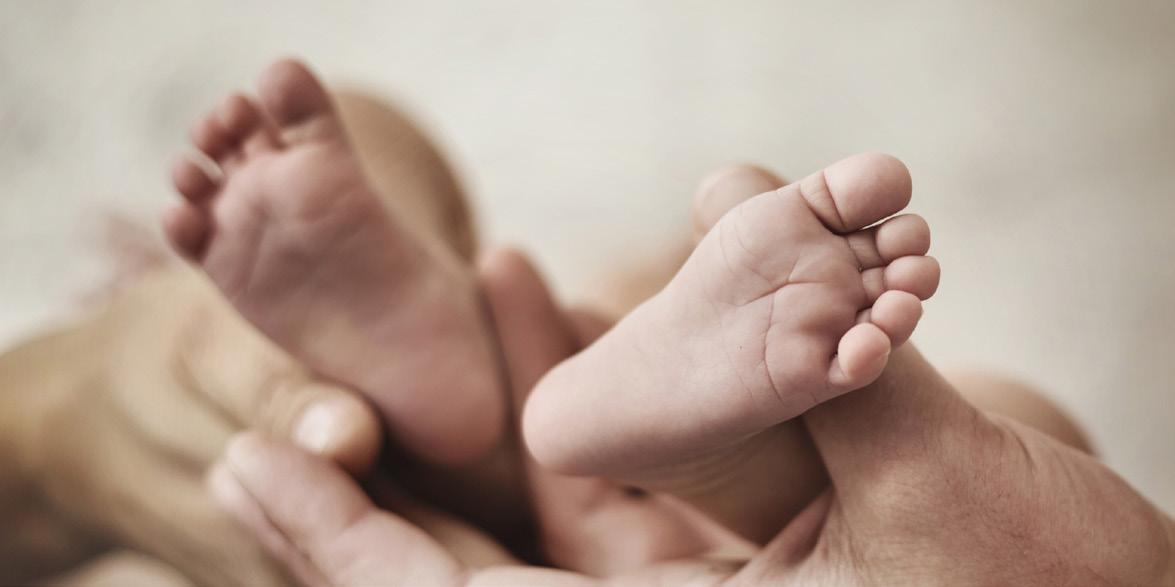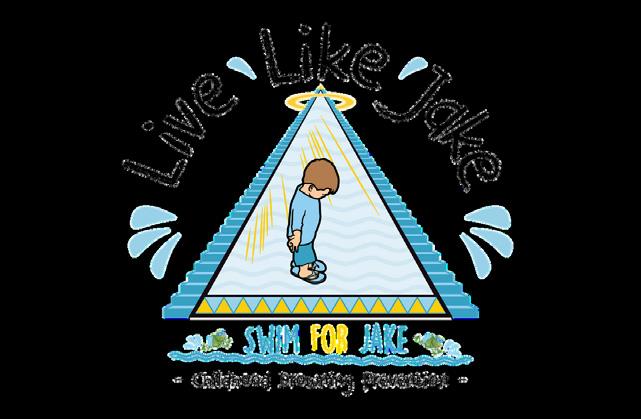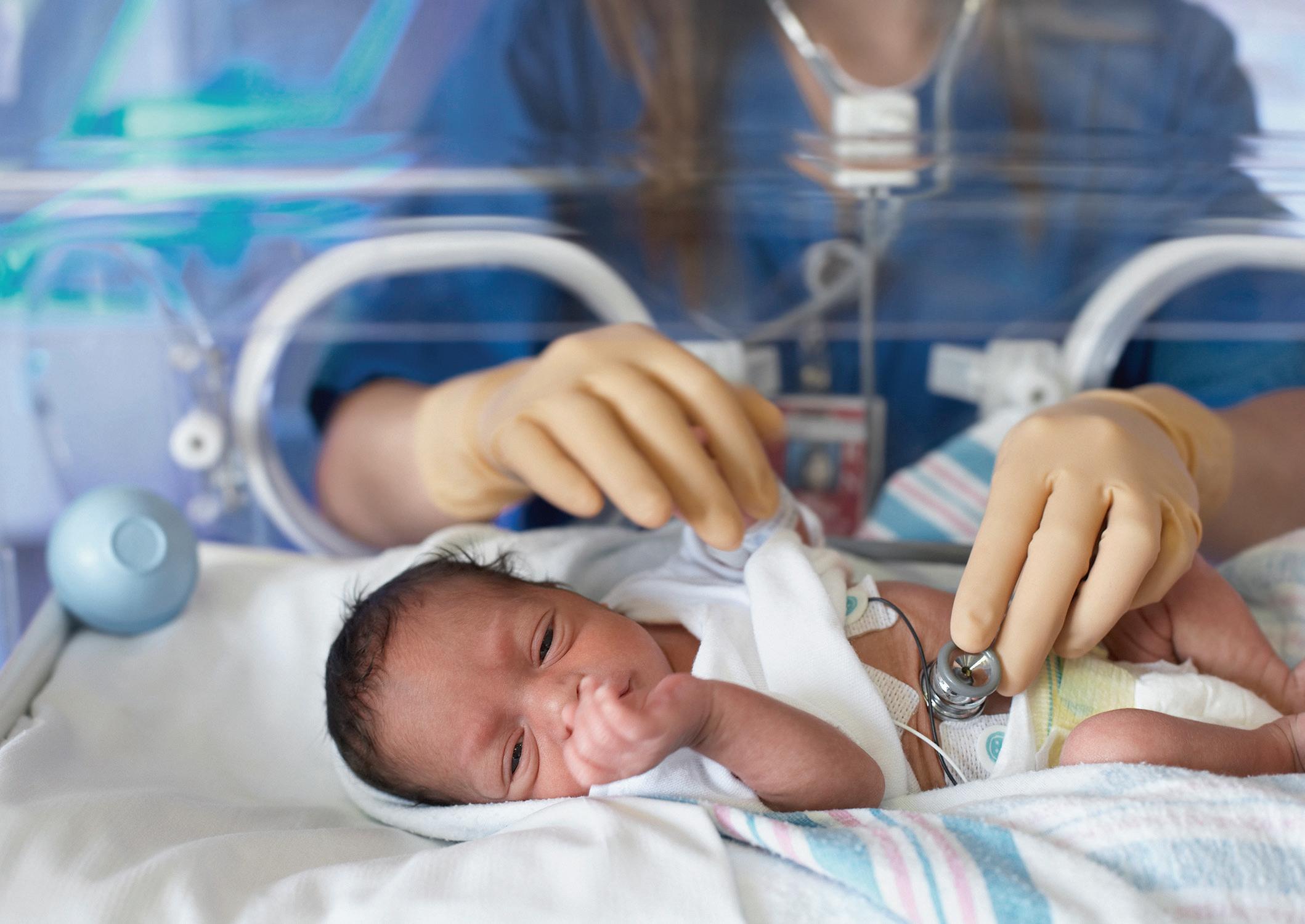
12 minute read
Bringing Your Baby Home
Whether your baby comes home from the hospital right away, arrives later (perhaps after a stay in the neonatal intensive care unit), or comes through an adoption agency, the homecoming of your little one is a major event you’ve probably often imagined. Here’s how to be prepared. Leaving the Hospital - Moms-to-be sometimes pack clothes for the trip home before even going to the hospital — or they may wait to see what the weather brings and have their partner bring clothing for both themselves and the baby. Plan to bring loose-fitting clothing for yourself with a drawstring or elastic waist because you most likely won’t fit into your pre-pregnancy outfits yet. Babies are often overdressed for the first trip home. Dress your baby as you would dress yourself. So, if you’d be too warm in a knitted hat during the summer, your baby probably will be, too. In warm weather, dress your baby in a T-shirt and light cotton pants or a baby blanket over bare legs. If it’s cold, put footie pajamas, a hat, and warm blanket over your baby. But be sure to keep all blankets far from your baby’s face to avoid suffocation.
Chances are much better that you’ll bring home a calm, contented baby if you don’t spend a lot of time at the hospital trying to dress your newborn in a complicated outfit that requires pushing and pulling your baby’s arms and legs. If you haven’t already made the arrangements with your baby’s health care provider, make sure to ask when the baby’s first checkup should be scheduled before you leave the hospital. Depending on the circumstances, some premature babies also go home with a special monitor for checking breathing and heart rate, and you may be taught infant cardiopulmonary resuscitation (CPR). But whether your baby is full-term or premature, don’t feel rushed out the door — have your questions answered before you leave the hospital. And if you find yourself wondering about anything

— from bathing to breastfeeding to burping — ask your nurse, lactation consultant, or your baby’s doctor.
The Car Trip - The most important item for the trip home is a proper child safety seat (car seat). Every state requires parents to have one before leaving the hospital because it’s one of the best ways to protect your baby. Even for a short trip, it’s never safe for one of you to hold your baby in your arms while the other drives. Your baby could be pulled from your arms and thrown against the dashboard by a quick stop. Consider buying, renting, or borrowing a car seat before your baby’s born, when you have time to choose carefully. There are two kinds of car seats for babies: infant-only seats (which must be replaced when your baby weighs 22 to 35 pounds, depending on the type of seat) and convertible seats that accommodate both infants and older children.
Infant-only seats are designed for rear-facing use only and fit infants better than convertible seats. The American Academy of Pediatrics (AAP) recommends that infants and toddlers ride in a rear-facing seat until they are 2 years old or until they have reached the maximum weight and height limits recommended by the manufacturer. Some parents of newborns find that a “travel system” (which includes a stroller and an infantonly car seat that can be attached to the stroller) makes it much smoother to transition babies — especially sleeping ones — from the car to the stroller. Convertible seats face toward the rear until your baby is at least 2 years old or has reached the maximum weight and height limits recommended by the manufacturer. A child who reaches the height and weight limits before age 2 is safest in a bigger convertible seat and kept rear facing. Kids who are small can remain in rear-facing seats even after age 2. (Follow the manufacturer’s guidelines for when to turn the seat.) Never put a rear-facing infant or convertible seat in the front seat of your car — always use the rear seat. Passenger-side airbags in the front seat cabin are hazardous for both rear- and forward-facing car seats, and most accidents happen at the front passenger area of the car. When it’s cold, strap your baby in snugly first, then put blankets over the baby. If you borrow a car seat, make sure that it’s not more than 6 years old and was never in a crash (even if it looks OK, it could be structurally unsound). Avoid seats that are missing parts or aren’t labeled with the manufacture date and model number (you’ll have no way to know about recalls). Also, check the seat for the manufacturer’s recommended “expiration date.” If you have any doubts about the seat’s history, or if it’s cracked or shows signs of wear and tear, don’t use it. When buying a new seat, it’s important to remember that there isn’t one type of seat that’s safest or best; get one that fits and can be correctly installed in your car. And higher price doesn’t necessarily indicate a seat’s quality — it could simply mean the seat has added features that you may or may not want or use. Also, be sure to register your new seat so you can be notified of any problems or recalls. The most common problem involving car seats is improper installation (according to the National Highway Traffic Safety Administration, the majority of all car seats are installed incorrectly). Recently,
LATCH (Lower Anchors and Tethers for Children) car seats have become standard in the United States, but a large percentage of these seats are improperly installed too. Don’t trust illustrations or store displays. Follow the manufacturer’s instructions (and keep them handy). Ask your doctor or nurse about local resources where your car seat can be checked by someone specifically trained to evaluate car seat installations. Many hospitals, police and fire stations, and even car dealerships offer this type of service for free. Make sure that the evaluation is done by someone trained and experienced. If you’re bringing your baby home from the intensive care unit, bring the car seat to the hospital ahead of time, so the staff can see if it will work for your baby. If special health concerns rule out a standard restraint, ask your child’s doctor to recommend car seats for children with special needs. For more information on the proper use of child safety seats, read our article on auto safety. First-Time Feelings - Don’t be surprised if you have mixed emotions as you bring your baby home, especially if this is your first child. You’ll likely be nervous. In fact, you may actually feel terrified as you realize that you’ve given up a certain amount of control over your life. If your baby wasn’t with you much at the hospital, you may not know what sort of schedule your little bundle of joy will keep. But you’ll know before long — although babies’ schedules do change a lot during those early months. You’ll be less stressed if you don’t overschedule yourself and can go with the flow.
Depending upon your labor and delivery experience, you may feel physically drained and sore. Your hormones may be struggling to catch up, too. Meanwhile, your partner may feel a little left out if you’re totally engrossed with the baby. You might have other kids awaiting the arrival of this newest family member. Or you may be dealing with a pet who’s wondering what’s suddenly drawn everyone’s attention. And the expectations of new grandparents, competitive siblings, or friends can also make the homecoming stressful. Your baby’s first extended crying period at home will be difficult. Remember: young babies typically cry for 1 to 5 hours within a 24-hour period, and can’t always be calmed. Crying usually decreases gradually after the first several weeks. Although it may seem impossible now, in a few months it will be difficult to recall your baby’s seemingly endless crying episodes. The Home Front - Introducing your baby to others at home can be challenging. If you have other kids, be sure to spend some quality time with each of them. Some parents bring home gifts from the new baby for big brothers and sisters. At first, you can expect some jealousy, especially if the main focus of your attention for several years suddenly has new competition. Encourage siblings to “help” you care for this newest family member. If you have a pet, ask your partner to bring home a blanket with the baby’s scent on it and place it near the pet — even before leaving the hospital. Then, when you come home, the pet will already be somewhat familiar with the baby. But remember to never leave pets alone with newborns. Family and Friends - Ask your partner to be the gatekeeper for visitors and to limit the number of guests at first. You’ll be glad later on if you take some time now to rest and become comfortable with your new situation. Although babies typically aren’t shy around strangers for the first 3 months or so, they may become overstimulated and tired if too many people are around. If you have voice mail or a telephone answering machine, consider changing your message to give the vital statistics of your new arrival. You might say something like: “Our newest family member has arrived. Her name is Julia Marie; she was born on Tuesday, and weighed 7 pounds, 10 ounces. We’re
all fine and adjusting to our new life. If you’d like us to call you back when it’s convenient, please leave your name and number.” Don’t be shy about accepting visitors slowly. Ask anyone who’s ill to wait until they’re feeling well and no longer contagious before they visit. You shouldn’t hesitate to ask visitors to wash their hands before holding your baby because a newborn baby’s immune system is not fully developed. When to Call the Doctor - Your baby’s health care provider expects calls from new parents on many topics, including breastfeeding and health concerns (for more on newborn care, visit the Pregnancy & Newborns section). They’d rather have you call than worry about something needlessly. If you wonder whether you should call the doctor’s office, do it, especially if you see something unexpected or different that concerns you. Call if you see any of these signs: • Rectal temperature of 100.4°F (38°C) or higher (in babies younger than 2 months) • Symptoms of dehydration (crying without tears, sunken eyes, a depression in the soft spot on baby’s head, no wet diapers in 6 to 8 hours) • A soft spot that bulges when your baby’s quiet and upright • A baby that is difficult to rouse rapid or labored breathing (call 911 if your baby has breathing difficulty and begins turning bluish around the lips or mouth) • Repeated forceful vomiting or an inability to keep fluids down • Bloody vomit or stool • More than eight diarrhea stools in 8 hours If your concern is urgent, call your doctor and take your child to the emergency room. Remember, with young infants, minor conditions can sometimes change quickly.
© 1995-2021. The Nemours Foundation/ KidsHealth®. Reprinted with permission.
Heated Indoor Pool located in Palm Beach Gardens Self-Rescue Swim Lessons Ages 6 months and older! www.livelikejake.com/pool/



10311 Ironwood Road, PBG, FL 33410
Self-Rescue Swim Scholarships Available Now!
Upcoming Events: www.livelikejake.com/events/


7th Annual 5K Run/Walk Riverbend Park, Jupiter, FL May 8, 2021 NEW LOCATION


How to Choose & Use Sunscreen
With all the sunscreens available these days, choosing the right one for your kids can be tricky. But what matters most when using a sunscreen is how well it protects skin from UV rays.
What Kind of Sunscreen Is Best?
When buying sunscreen, there are three important things to look for. Check the label for a sunscreen that: • has an SPF (sun protection factor) of 30 or higher • protects against both UVA and UVB rays (a
“broad-spectrum” sunscreen) • is water-resistant (protects kids while in the water for 40–80 minutes)
Different Types of Sunscreen
Sunscreen comes in different types: creams, gels, sprays, and sticks. Creams are best for dry skin areas, sticks help around the eye area, and gels are good for areas with hair (like the scalp). Sunscreen sprays can make it hard to know if you’ve applied enough, and there’s a chance that kids could breathe in the fumes. Some sprays are also flammable, so you need to avoid sparks or flames when using it.
Other Things to Know
• Don’t use sunscreens with PABA, which can cause skin allergies. • For sensitive skin, look for products with the active ingredient titanium dioxide. • Teens or preteens who want to use a selftanner sunscreen should get one that also has UV protection (many offer little or none). • Some cosmetics contain sunscreen, but usually don’t offer enough protection from the sun. Make sure your teen puts sunscreen on before applying makeup.
Babies younger than 6 months should be kept out of the sun. When going outside, dress your baby in lightweight clothes that cover arms and legs — and don’t forget a hat with a brim. If you can’t avoid the sun, you can use a small amount
How, When, and Where to Use Sunscreen
For sunscreen to do its job, it must be used correctly. Be sure to: • Apply sunscreen whenever your kids will be in the sun. For best results, apply sunscreen about 15 to 30 minutes before kids go outside. • Don’t forget about ears, hands, feet, shoulders, and behind the neck. Lift up bathing suit straps and apply sunscreen underneath them (in case the straps shift as a child moves). Protect lips with an SPF 30 lip balm. • Apply sunscreen generously — dermatologists recommend using 1 ounce
(enough to fill a shot glass or plastic medicine cup) to cover the exposed areas of the body. • Reapply sunscreen often, about every 2 hours. • Reapply after a child has been sweating or swimming.
Apply a water-resistant sunscreen if kids will be around water or swimming. Water reflects and intensifies the sun’s rays, so kids need protection that lasts. Water-resistant sunscreens may last up to 80 minutes in the water, and some are also sweat-resistant. But regardless of the waterresistant label, be sure to reapply sunscreen when kids come out of the water.
Don’t worry about making a bottle of sunscreen

WE ARE OPEN! WE ARE OPEN!Go online or call Go online or call to reserve your to reserve your party today! party today!




